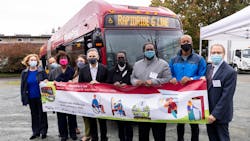FTA, leaders launch construction on King County Metro’s future RapidRide G Line
Local and federal officials joined King County Metro at a groundbreaking event to celebrate the start of construction on the Madison – RapidRide G Line.
This bus rapid transit (BRT) project is one of Seattle’s biggest projects within the Levy to Move Seattle. When the RapidRide G Line opens in 2024, it will connect some of Seattle’s densest neighborhoods with frequent, reliable transit.
“We are celebrating the start of a historic groundbreaking and the culmination of a collaborative planning effort with community members and across partner agencies. Working together on a federal, state, regional and municipal level made the RapidRide G Line a reality,” said King County Metro General Manager Terry White. “I look forward to returning to the corner of Rev. Samuel B. McKinney and Madison streets to celebrate the start of the RapidRide Service to the neighborhoods it will serve. The G Line will also better connect these neighborhoods with our regional mobility network.”
The Madison – RapidRide G Line is a partnership between King County Metro, the city of Seattle and Sound Transit. It will create a frequent and reliable public transportation line between 1st Ave and Martin Luther King Jr Way. The route will serve dense neighborhoods in downtown Seattle, First Hill, Capitol Hill, the Central District and Madison Valley. It will connect people to hospitals, schools and universities, and businesses as well as to dozens of bus routes, the First Hill Streetcar, the West Seattle and Vashon Water Taxi at Pier 50, and ferry service at the Colman Dock Ferry Terminal.
“By making it easier to board, easier to pay and ensuring more buses per hour, the RapidRide G Line will better connect the people of Seattle, encouraging more people to get on board,” said FTA Administrator Nuria Fernandez. “FTA is proud to join our partners in the Seattle area to expand the bus rapid transit network in western Puget Sound.”
The improved bus route will connect to transit across the region including light rail, ferries and regional bus lines. A detailed map of the project and how it will connect with Seattle’s larger Transit-Plus Multimodal Network is available online.
The project will build new sidewalks, repave the street and change the lane layout to make the bus more reliable, accessible and easier to get to. The city of Seattle will build curb ramps, add streetlights and build five new traffic signals with crosswalks to make it safer and more comfortable for people to get to and from bus stops. A complete list of all the many project benefits is available on the Madison BRT – RapidRide G Line web page, including detailed renderings of the final designs.
“The up to $35.8 million dollars that Sound Transit invested in this project will improve the lives of thousands of riders travelling to and from one of Seattle’s dense and vibrant neighborhoods, giving them outstanding connections to our fast-expanding regional transit system,” said Sound Transit CEO Peter Rogoff. “We thank the city of Seattle and King County Metro Transit for leading the partnership to make this project happen, and the Federal Transit Administration for their funding to enable it.”
The project would not be possible without the support of Seattle voters who passed the Levy to Move Seattle in 2015. One of the ways which the Levy to Move Seattle amplifies the value of tax dollars is by helping to leverage funding from other regional, state, and federal transit agencies, making it possible to accomplish more than would have been possible with local funding alone.
The Federal Transit Administration is contributing $80.5 million to the $133.4 million project. This includes $10.9 million from President Joe Biden’s American Rescue Plan, $59.9 million from the Small Starts Grant program and another $9.7 million from the Congestion Mitigation and Air Quality Improvement Program.
Sound Transit is also contributing up to $35.8 million to the project, as part of a Capitol Improvement Program agreement with King County Metro. This project will be one of the first of many Sound Transit 3 commitments which will be completed in the coming years.
The RapidRide G Line is one of many major transit investments the Levy is delivering to create a more connected city, along with other major transit investments like the RapidRide H Line on Delridge Way SW, RapidRide J Line along Roosevelt and Eastlake avenues, and other Transit-Plus Multimodal Corridors throughout Seattle.
Seattle Department of Transportation will work to build the project as efficiently as possible while maintaining access and mobility. The work will be done in sections along the project area and work will generally occur on weekdays between 7 a.m. and 5 p.m. At least one lane of traffic will be kept open in each direction most of the time, but there will be some times crews have to close intersections, typically on weekends or overnight.
